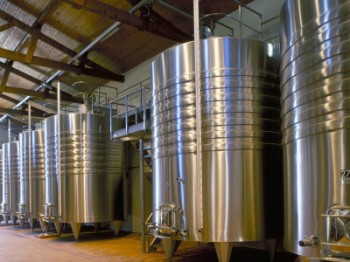Acids In Wine
 October 13, 2010
October 13, 2010

Six acids make up the primary acids used in the wine making process. They have a direct influence on the taste, color and acidity level of the resulting wine. Three of the acids in wine are found within the grapes themselves and three come from the yeasts most often used during fermentation. In the grape you have: tartaric acid, malic acid and citric acid. Fermentation acids include succinic acids, lactic acids and acetic acids. We’ll go into all of these later. First let me mention that all of these, the acids in the grapes and the yeasts, with the exception of acetic acid, are fixed acids. This means that during the distillation process the acids will remain in the wine residue and will not leak into the juice. Acetic acid will transfer to the wine during distillation, where it becomes a volatile acid. Too much acetic acid and your wine will take on a vinegary taste. This is a wine fault known as volatile acidity.
So, let’s look more closely at the grape acids, and then I’ll go into fermentation acids.
Grape Acids In Wine
- Tartaric acid: You know that bitter, salty taste of aspirin? That’s what tartaric acid in wine tastes like. It’s found in the stems of the grapevine and is extremely resistant to bacteriological attacks. The wine must loses about half of its tartaric acid levels during cold stabilization. This process lasts three to four weeks so that the crystals don’t form in the wine after going to market. They remain in the tank or casks, whatever is used during the cold stabilization process.
- Malic acid: Bite into a green apple and you’ll get the taste of malic acid. The word malic actually comes from the Latin word for apple, malum. It’s a fragile acid and breaks down easily during fermentation, where it can be converted to lactic acid to give some wines, like Chardonnay, that buttery, creamy mouthfeel.
- Citric Acid: Not so prevalent in grapes as much as it is in other acidic fruits, but there’s enough to be noticed. Still, many producers will add small quantities of citric acid during the wine making process to boost wine acidity, in the case of sweet wines, where needed.
Fermentation Acids
- Succinic Acid: This is the bitter, salt-sour aftertaste of a warm beer. It’s in all alcoholic beverages but is really noticeable in beer. Succinic acids are formed by the yeasts during primary fermentation as a result of converting sugars. The taste is a little more prevalent in red wines, but exists in all wines to a lesser degree.
- Lactic Acid: Mentioned briefly above, lactic acid is formed by yeasts during the primary fermentation where the grape sugars are converted to alcohol. It’s made by adding lactic bacteria to the malic acid in wine during malo-lactic fermentation. The result by itself is closely related to the creaminess of milk, but it softens acidity in wine and adds a delicious creaminess. Too much lactic acid, however, and you could end up with a wine that tastes like sauerkraut.
- Acetic Acid: Taste some vinegar. That pucker that you get is from ascetic acid. There’s a little that gets into wine after fermentation, as the wine oxidizes, but it’s not typically noticeable. The more the wine oxidizes, the more ascetic acid is produced, which is wine eventually tastes of vinegar if left exposed to the air.
The total acidity of wine (known as TA) is the sum total amount of acid in wine. It can be quantified during the process. It’s not a measure of the strength of acids in wine, but an actual amount of acids used or produced. For the strength of acids, a pH measurement is needed. You can get a general sense of how acidic a wine is through mouthfeel. Wine has its own range of pH measurement. It doesn’t take much to make a wine highly acidic. It might seem a little confusing but the lower the pH the higher acidity level a wine will have. And in the reverse, the higher the pH level the softer a wine will be. A low end of a wine’s pH (high acidity) is about 2.9. The high end of that is about ten times the low at 3.9.
When talking about acids in wine, you have to mention bacteria as well. Wine is mostly an acidic beverage. While bacteria cannot generally survive in a highly acidic environment, two bacteria are used to actually bring down the levels of acidity. These are lactic bacteria and acetobacter. As I’ve already mentioned, lactic bacteria is added to a wine to bring down the acidity and give the wine a creamier mouthfeel. While this is a method often used to soften wines, a wine maker will try to avoid the latter being introduced into the wine. Acetobacter is what gives wine its vinegary taste as it oxidizes. Oxidation is kept to a minimum in most cases of wine making. Madeira is the exception in this case, where oxidation plays a key role in the production of Madeira.
Related posts:
 Subscribe
Subscribe
 Posted in
Posted in 



